#grow food not lawns
Text


Central Rocky Mountain Permaculture Institute
10/15/23
Basalt, CO
#permaculture#crmpi#central rocky mountain permaculture institute#horticulture#organic gardening#colorado#cottagecore#grow food not lawns#grow food#biodiversity#save our earth#naturecore#my photos#rocky mountains#greenhouse
95 notes
·
View notes
Text
youtube
Today I'm walking you through some simple tips on how to turn your lawn or backyard into a productive vegetable garden to grow your own food!
Gardening Guide for Beginners:
http://robgreenfield.org/freeseedproj...
Robin Greenfield’s Guide to Gardening for Beginners in Orlando, Florida:
http://robgreenfield.org/grow/
Thank you to Live Like Ally Foundation for their partnership in making this video. To learn more about Like Like Ally Foundation visit: https://www.llafoundation.com/
"Like" Live Like Ally on Facebook: https://www.facebook.com/livelikeally...
Follow @live_like_ally on Instagram: https://www.instagram.com/live_like_ally
Meet Ally: • Positively Impact...
Filmed and edited by John VonMutius http://johnvonmutius.com
Robin Greenfield’s work is Creative Commons and this content is free to be republished and redistributed, following the terms of the creative commons Attribution-NonCommercial 4.0 license. Learn about Creative Commons and see the guidelines here: http://www.creativecommons.org/licens...
—
Robin Greenfield is an activist and humanitarian dedicated to leading the way to a more sustainable and just world. He embarks on extreme projects to bring attention to important global issues and inspire positive change. 100% of his media income is donated to grassroots nonprofits.
His YouTube channel is a source to educate, inspire and help others to live more sustainable, equal and just lives. Videos frequently cover sustainable living, simple living, growing your own food, gardening, self-sufficiency, minimalism, off the grid living, zero waste, living in a tiny house and permaculture.
Find Robin Greenfield on:
Website: https://www.RobGreenfield.org
Instagram: https://www.instagram.com/RobJGreenfield @RobJGreenfield
Facebook: https://www.facebook.com/RobGreenfield
YouTube: / robgreenfield
Twitter: https://twitter.com/RobJGreenfield @RobJGreenfield
—
Help us caption & translate this video!
https://amara.org/v/C0JNV/
#Robin Greenfield#solarpunk#grow food not lawns#food not lawns#gardening#orlando#florida#USA#lawns#anti lawn#garden#food gardening#Youtube#alternative lawn#lawn alternatives
51 notes
·
View notes
Text

4/7/24 ~ transplanted some stuff that was left over in my seed tray that I neglected 🥲 They aren’t too happy right now 🙃🌱
Some of them are Tamarillos. Anyone familiar with those? It was a random purchase for me 😋
#tamarillo#transplanting#starting seeds#tomato farming#pepper garden#growing peppers#sustainable gardening#edible landscaping#permaculture#indoor garden#container gardening#vegetable gardening#growing food#plant life#plant mom#veganuary#grow organic#grow food not lawns
6 notes
·
View notes
Video
youtube
diy medicinal herb remedies
0 notes
Text
Grassassination II: Revengeance.
If you go on an allergy diet, you do it by eliminating common allergens, then re-introducing them one at a time over a period of weeks. This lets you figure out exactly what you’re reacting to, and how.
If you have sensitive skin, you probably also know not to add a lot of new products to your routine all at once. You add them one at a time, with space in between, so you can see how your skin…

View On WordPress
#Environment#environmental responsibility#environmentalism#grass#grow food not lawns#health#life#plants#screw this lawn
0 notes
Link
#grow food not lawns#kill your lawn#permaculture#garden#farming#urban farming#green#nature#summer#spring#purple#fruit#vegan
0 notes
Text


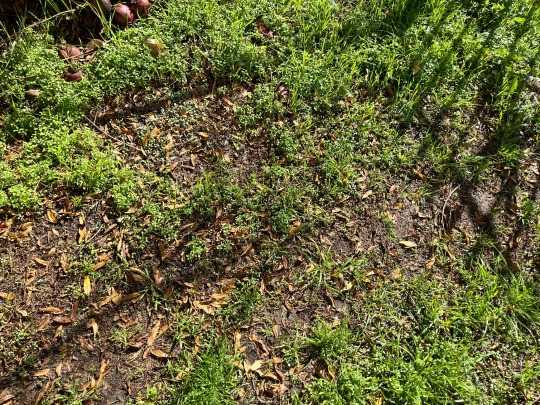
I’m restoring a backyard that needs some love. I decided to fill in the bare areas with 3 types of clover instead of grass. I’ve been spreading seeds between the rain.
40 notes
·
View notes
Text
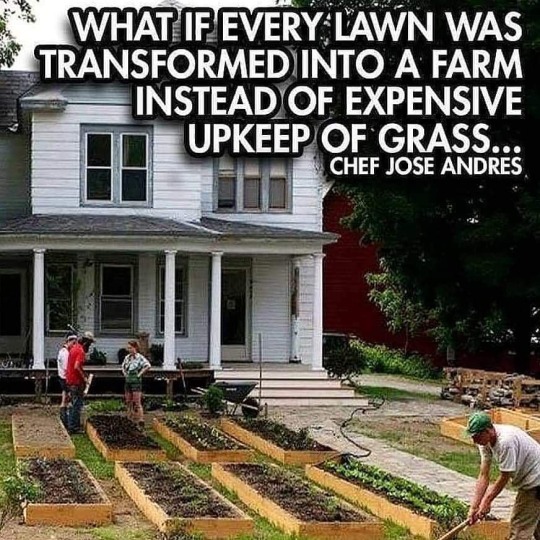
#Plants#Permaculture#food not lawns#grow your own food#chef jose andres quote#garden inspiration#Places
171 notes
·
View notes
Text
A basic starter project if you want to start growing your own food but have no money & no experience, assuming you like green onions.
Supplies needed: Dead potted plant from free pile/dumpster/friend or family member, used food container, green onion ends.

Steps:
1. Remove lid from container, it's now your plant pot's saucer

2. Either poke holes very carefully and slowly (not ideal) or slice the corners off with scissors (better)

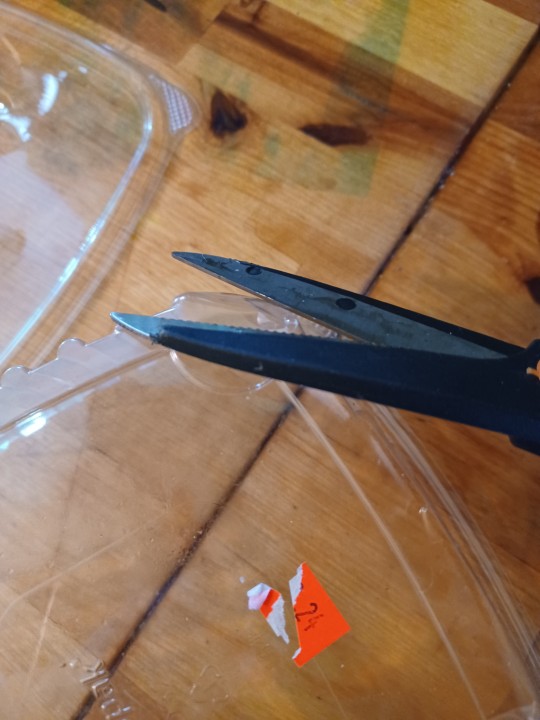
3. Remove soil from the dead plant's pot, put in container. This one was super heavy in perlite (the white stuff, helps with drainage), so I mixed in another pot that had more organic matter (brown stuff, mostly helps retain moisture, sometimes provides nutrients). Water until water comes out the bottom, then let drain in sink until until it's done. Put pot on lid:

4. Stick the green onions in, deep enough that they can stand up on their own, or until the white part is covered:
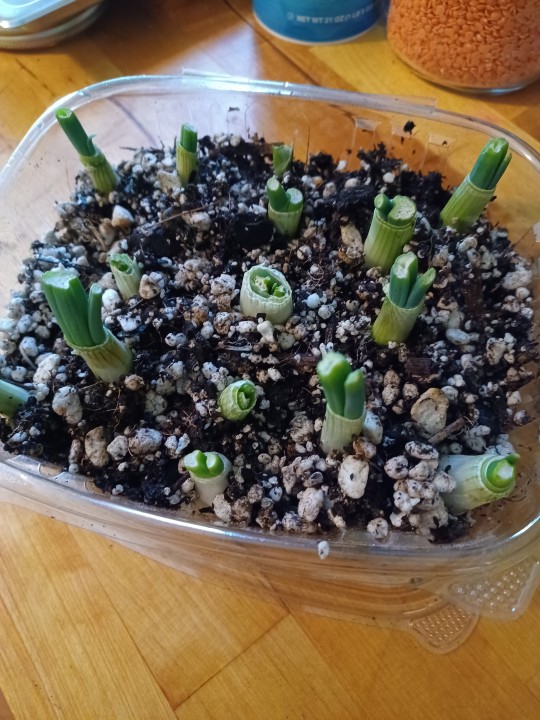
5. Stick in window, water when dry, and wait:
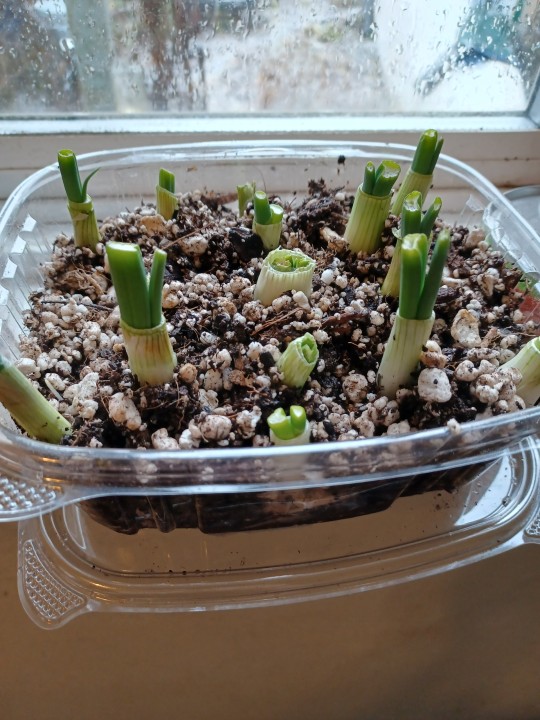
Why not just stick them in water?
Because they make the water really smelly.
Just change the water often, then it won't stink.
I will forget, and then it will stink. Plus, I prefer growing in soil.
Why do you prefer soil?
Thanks for asking! I started because growing them in water didn't work well for me. But on top of that, if you regrow in water, eventually their growth will peter out. This is because in addition to water and carbon dioxide, plants need other nutrients. These are stored in the bulbs of green onions, but they will be depleted by growth if the plant can't replace them. Potting soil often has leftover nutrients, and if you've got compost you can also mix that in.
Why not just put fertilizer in the water?
Two reasons. First off, that's a great way to grow algea, unless you make sure the water isn't getting light. Secondly, most cheap, widely available fertilizers are meant to be used for plants that are in soil, so they're not complete (they're missing iron and maybe some other things? It's been a while since i looked it up). So eventually, if you use water and normal ferts, the plant will stop growing. If you have access to hydroponic ferts, those would work, but you also have enough money that you're not the target audience for this post.
I don't trust the potting soil from random plants.
Completely understandable, and probably smart too. In that case, you have a couple other options if you want soil for free. First off, you could look for dead vegetable or other edible plants in pots, and know that those will not have been treated with something that makes them inedible to humans. You can also look for free bags of partially used potting soil in your local buy-nothing/free stuff groups/craigslist/nextdoor/mutual aid groups.
What if I have some money for soil?
Then you can look for potting soil, or make your own (plenty of recipes online for this)
Help! There are tiny flies that look like fruit flies!
Those are probably fungus gnats, and there's plenty of ways to get rid of them. My two favorites are watering a bit less and adding half an inch of sand to the top, making your plants an unsuitable habitat, or getting a mosquito dunk and keeping it in your watering can. Mosquito dunks have Bt, a type of bacteria that kills mosquitos, fungus gnats, and other related insects. There are other types of Bt that go after other types of insect, such as cabbage moths. It's considered an organic treatment.
What about other pests?
I've literally never seen them get other pests indoors.
How much light do they need?
As much as you can give them, probably. If you have a window that gets midday sun, use that. Or a grow light. If they don't get enough light, they'll be floppy and pale, still edible, but not as flavorful.
When can I harvest?
When it wouldn't look silly to harvest them. I generally wait until they're at least a foot tall (30cm). I'll post an update when I do.
Why didn't you just use the dead plant's pot, dumbass?
A) it didn't have a saucer to protect the surface underneath, B) this is a concept post, and often plant pots are too wide to fit in window sills, and C) I didn't like the pot.
Won't it just grow into a bulb?
Nope, green onions are actually usually a different type than bulbing onions. Usually. And they're perennial! I've never had one try forming a bulb, but you can just eat them if yours do.
Can I ask you another question?
Yep! I'll add it to the update.
195 notes
·
View notes
Text




Roasted butternut, garlic and sage from the garden, folded into risotto with feta, toasted pine nuts and pecans.
#cooking#vegetarian#grow food not lawn#grow food#butternut pumpkin#butternut squash#fuck yeah pumpkins#risotto#home cooking#kitchen witch#friday night dinner
7 notes
·
View notes
Text
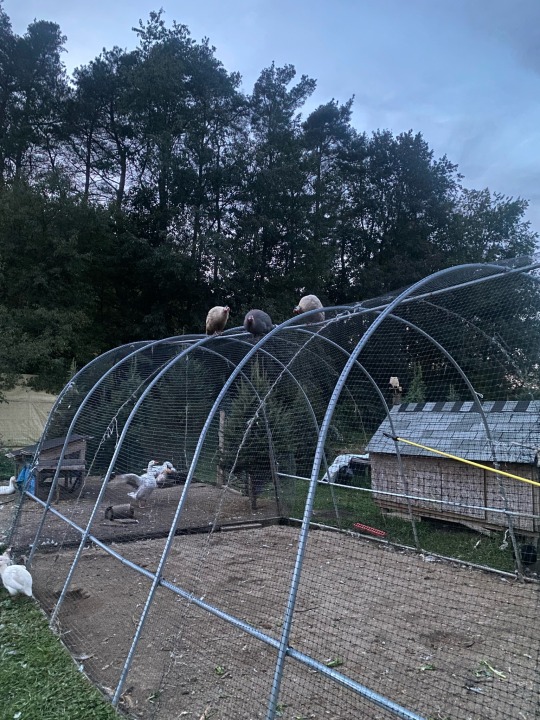

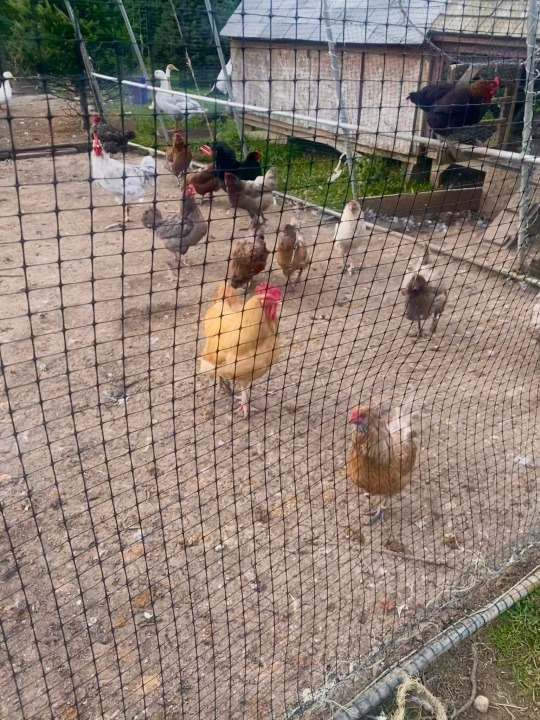

the homestead
#homestead#cottagecore#farm#farmcore#cows#chickens#quail#eggs#grow food not lawns#garden#naturecore#our cow’s name is Freya :)
10 notes
·
View notes
Text
youtube
You don't always need a farm to grow your own food. Edible landscapes and food forests can be grown and enjoyed right in your own backyard. With a little knowledge, trial and error, and continued practice, you can learn to grow all sorts of wonderful fruits and vegetables even in the middle of the suburbs.
Start growing your own food forest with a pack of heirloom seeds: https://amzn.to/3HSnT7z
Watch more from Justin: / herballyfstyl
Don't forget to LIKE, COMMENT, SUBSCRIBE, & SHARE!
BEHIND THE SCENES: https://www.patreon.com/PARAGRAPHIC
PRODUCTS & SERVICES: https://paragraphic.io/
AMAZON STOREFRONT: https://www.amazon.com/shop/paragraphic
BOKEH SUPPLEMENTS: https://bokehrola.com/
JOIN THE MULTITUDE: https://www.multitude.io
FOLLOW US @theparagraphic https://www.instagram.com/theparagrap...
LEARN MORE AT https://theparagraphic.com/
What is a food forest?
A food forest is an edible landscape that is modeled after a natural forest ecosystem.
A food forest is an excellent way to produce a large quantity of food with minimal effort. Once established, a food forest will require little to no maintenance and will provide an abundance of fresh fruits, nuts, and vegetables throughout the growing season.
A food forest can be created on any size piece of land, from a small urban backyard to a large rural property. The key to success is to design and plant the food forest in such a way that mimics the structure and function of a natural forest ecosystem.
The benefits of establishing a food forest are many. In addition to providing an abundance of fresh, healthy food, a well-designed food forest can help to improve soil quality, increase biodiversity, and provide habitat for wildlife.
Where can you grow a food forest?
A food forest can be grown in any backyard, regardless of size. The key to success is starting with a plan and design that takes into account the specific conditions of your yard.
The first step is to perform a site analysis, which will help you understand the microclimates, sunlight, soil type and drainage in your yard. With this information, you can select the right plants for your food forest.
Once you have a plan, the next step is to prepare the soil. This may involve adding amendments to improve drainage or adjusting the pH level. Then, it's time to start planting!
When selecting plants for your food forest, consider both annual and perennial crops. Annuals will provide a quick harvest, while perennials will provide a longer-term food source. Be sure to include a mix of fruits, vegetables, nuts and herbs in your planting scheme.
As your food forest grows, it's important to keep an eye on weeds and pests. Hand-pulling or using mulch can help control these problems naturally. With a little care and attention, your backyard food forest will thrive!
Assuming you have the space, there's nothing more gratifying than growing your own food. And, while a traditional vegetable garden has its merits, why not go big and plan for a food forest? With a little bit of planning (and some hard work), you can create a backyard oasis that will provide you with an abundance of fresh fruits and vegetables for years to come.
Here are a few tips to get you started:
1. Choose the right location. Make sure you pick a spot that gets plenty of sunlight and has well-drained soil.
2. Select a variety of plants. When it comes to fruit and vegetables, the more the merrier! Plant everything from berries and grapes to tomatoes and potatoes.
3. Give them room to grow. Remember, most fruits and vegetables need room to spread out so don't plant them too close together.
4. Be patient! It takes time for a food forest to reach its full potential but it will be worth the wait!
Growing your own fruit and nuts can save you money at the grocery store, and it’s a great way to get outdoors and enjoy some fresh air while you’re tending to your garden. Food forests can also provide habitat for wildlife, and can help to purify the air and water in urban areas.
• • • • • • • •
ABOUT PARAGRAPHIC:
Handcrafted documentaries featuring artisans of all trades. We are filmmakers who tell the stories of creators, makers, entrepreneurs, and artists. The ones who have committed everything to their craft. From garage bakeries and mushroom farms to backyard aquaponics and innovative fabricators, these stories will take you behind the brand and show an inside look at the people who make it happen.
-Of the earth, from the plough
#foodforest #ediblelandscape #garden
#PARAGRAPHIC#solarpunk#food forest#garden#gardening#food#plants#edible landscaping#urban gardening#food not lawns#grow food#Youtube
3 notes
·
View notes
Text
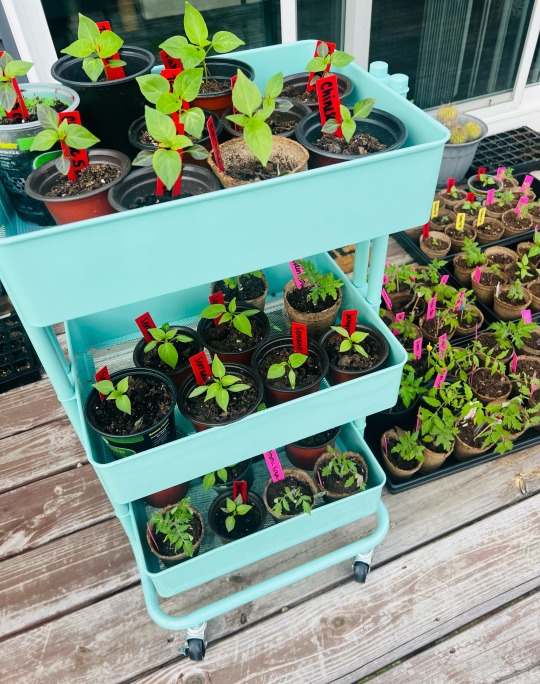
4/16/24 ~ a transplantation needs to be happen’ 😅😆
Update on the lil babies
#indoor garden#sustainable gardening#container gardening#vegetable gardening#starting seeds#growing food#plant life#plant mom#veganuary#homesteading#growing peppers#tomato farming#transplanting#grow food not lawns#food not lawns
3 notes
·
View notes
Text
Bug photography season is baaaaack
A ground dwelling native mining bee, Andrena spp. enjoying our early blooming pussy willow tree, Salix spp.
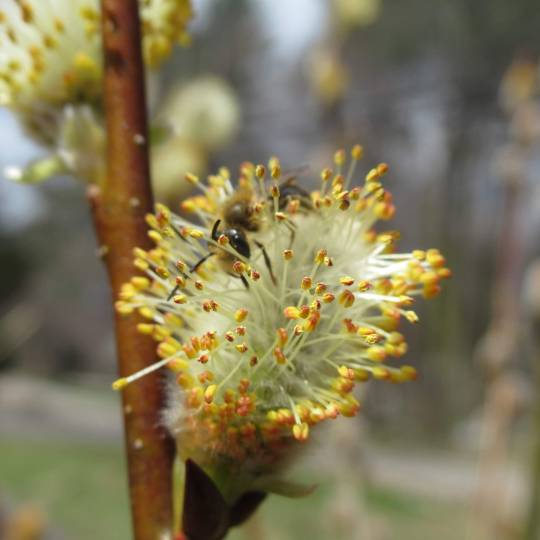

#bees#pollinator garden#spring#gardening#native bees#native plants#kill your lawn#grow food#climate change#bugs#insects#nature#beeposting
12 notes
·
View notes
Text
What i've been learning thru my research is that Lawn Culture and laws against "weeds" in America are deeply connected to anxieties about "undesirable" people.
I read this essay called "Controlling the Weed Nuisance in Turn-of-the-century American Cities" by Zachary J. S. Falck and it discusses how the late 1800's and early 1900's created ideal habitats for weeds with urban expansion, railroads, the colonization of more territory, and the like.
Around this time, laws requiring the destruction of "weeds" were passed in many American cities. These weedy plants were viewed as "filth" and literally disease-causing—in the 1880's in St. Louis, a newspaper reported that weeds infected school children with typhoid, diphtheria, and scarlet fever.
Weeds were also seen as "conducive to immorality" by promoting the presence of "tramps and idlers." People thought wild growing plants would "shelter" threatening criminals. Weeds were heavily associated with poverty and immortality. Panic about them spiked strongly after malaria and typhoid outbreaks.
To make things even wilder, one of the main weeds the legal turmoil and public anxiety centered upon was actually the sunflower. Milkweed was also a major "undesirable" weed and a major target of laws mandating the destruction of weeds.
The major explosion in weed-control law being put forth and enforced happened around 1905-1910. And I formed a hypothesis—I had this abrupt remembrance of something I studied in a history class in college. I thought to myself, I bet this coincides with a major wave of immigration to the USA.
Bingo. 1907 was the peak of European immigration. We must keep in mind that these people were not "white" in the exact way that is recognized today. From what I remember from my history classes, Eastern European people were very much feared as criminals and potential communists. Wikipedia elaborates that the Immigration Act of 1924 was meant to restrict Jewish, Slavic, and Italian people from entering the country, and that the major wave of immigration among them began in the 1890s. Almost perfectly coinciding with the "weed nuisance" panic. (The Immigration Act of 1917 also banned intellectually disabled people, gay people, anarchists, and people from Asia, except for Chinese people...who were only excluded because they were already banned since 1880.)
From this evidence, I would guess that our aesthetics and views about "weeds" emerged from the convergence of two things:
First, we were obliterating native ecosystems by colonizing them and violently displacing their caretakers, then running roughshod over them with poorly informed agricultural and horticultural techniques, as well as constructing lots of cities and railroads, creating the ideal circumstances for weeds.
Second, lots of immigrants were entering the country, and xenophobia and racism lent itself to fears of "criminals" "tramps" and other "undesirable" people, leading to a desire to forcefully impose order and push out the "Other." I am not inventing a connection—undesirable people and undesirable weeds were frequently compared in these times.
And this was at the very beginnings of the eugenics movement, wherein supposedly "inferior" and poor or racialized people were described in a manner much the same as "weeds," particularly supposedly "breeding" much faster than other people.
There is another connection that the essay doesn't bring up, but that is very clear to me. Weeds are in fact plants of the poor and of immigrants, because they are often medicinal and food plants for people on the margins, hanging out around human habitation like semi-domesticated cats around granaries in the ancient Near East.
My Appalachian ancestors ate pokeweed, Phytolacca americana. The plant is toxic, but poor people in the South would gather the plant's young leaves and boil them three times to get the poison out, then eat them as "poke salad." Pokeweed is a weed that grows readily on roadsides and in vacant lots.
In some parts of the world, it is grown as an ornamental plant for its huge, tropical-looking leaves and magenta stems. But my mom hates the stuff. "Cut that down," she says, "it makes us look like rednecks."
9K notes
·
View notes
Text
Our 2023 garden: spinach and alternative lawn mix
My daughters were out early, taking care of some planting for me, so here are some “after” pictures. 😊
The first area they worked on were the bald patches in the maple grove.
These are where the branch pile we got chipped last summer had been sitting for about four years. The first thing they did was use the thatching rake to break up and loosen the soil, then raked it smooth. For the patch in…

View On WordPress
#2023 garden#alternative lawn#cold climate gardening#cool weather crops#growing food#planning ahead#plant protection#planting#self sufficiency#spinach
1 note
·
View note